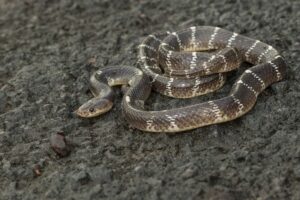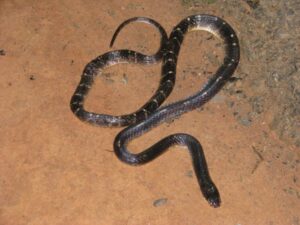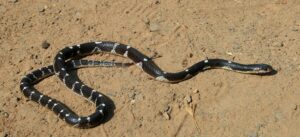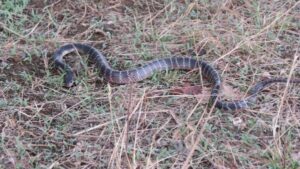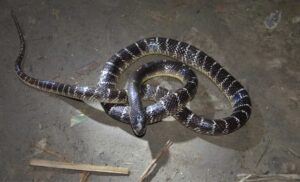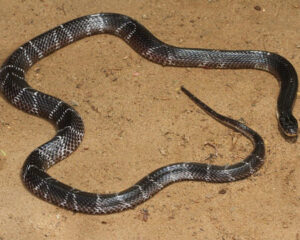The common krait, or Bengal Krait, is a highly venomous elapid snake in the Indian subcontinent. It is one of the “Big Four” snakes in India, along with Russell’s viper, the Indian cobra, and the Indian saw-scaled viper. It is one of the 16 species in the genus Bungarus.
The word “krait” comes from the Hindi word “karait.” These snakes are often termed as ‘dangerous’ because it causes the most number of snakebites to the people living in the Indian subcontinent.
Notwithstanding their reputation, the common kraits are mild-tempered snakes that prefer to avoid disturbances. They are quiet and static during the day and remain hidden in loose soil, rodent holes, or beneath brick and rubble piles. They roll their bodies to form a loose, coiled “ball” in which their head is nicely concealed and can be handled considerably in this condition. They only come out at night but are challenging to handle as they are more active and can hiss loudly or bite if disturbed.
Scientific Classifications
- Suborder:Serpentes
- Family:Elapidae
- Genus:Bungarus
- Species:B. caeruleus
Conservation Status
Description
Size
Their body length is about 35 – 60 inches (90 – 175 cm). Males are longer than females.
Color and Appearance
Common kraits are black or bluish-black in color. They have about 40 or so white, narrow crossbars that are absent or unclear near the head and highly prominent in juveniles. But as the snake ages, the crossbars fade, becoming a series of connected dots with one prominent spot in the vertebral region.
They also have albino specimens, which are very rare. Their body is cylindrical, tapering off towards their short and rounded tails. Their eyes are small with round pupils. They have normal head shields with no loreals. Four shields are along the margin of the lower lip, and the third and fourth supraoculars touch the eye.
Their body is covered with 15-17 rows of highly polished scales. The vertebral row is hexagonal and distinctly enlarged. They may have a white preocular spot and white belly and upper lips.
Are They Dangerous to Humans
A bite of the common krait can cause muscle paralysis in humans because its venom contains potent neurotoxins. The LD50 values of its venom are 0.169 mg/kg intravenously, 0.325 mg/kg subcutaneously, and 0.089 mg/kg intraperitoneally. Its average venom yield is 10 mg, whereas only 2-3 mg is dangerous to humans.
Presynaptic and postsynaptic neurotoxins are present in their venom, which usually affects the synaptic cleft (the points of information transfer between neurons).
Its bite is not very painful, and the sensation is like an ant or mosquito bite, so people often don’t take it seriously until symptoms start appearing. However, the impact can be fatal. After the bite, the victim can experience tightening of the facial muscles, inability to see and talk, and abdominal cramps accompanied by progressive paralysis. Death might occur within 4-8 hours due to respiratory paralysis (suffocation) if the patient is left untreated.
These snakes don’t bite often. When disturbed, they conceal their head, flatten their body and make jerky movements. But if they become agitated, they bite and hold on for a while, letting them inject a lot of venom. They are more likely to bite at night when they become aggressive if disturbed. The common kraits are responsible for the second-highest number of snakebites in India for a single species.
Common Krait at a Glance
Distribution
Common kraits are found in the Indian subcontinent. Their range is from Sindh to West Bengal and throughout South India and Sri Lanka, where they are found at an elevation of about 5,200 ft (1600 m). They also live in Bangladesh, Afghanistan, and Nepal.
Habitat
They inhabit various habitats, from fields and low-scrub jungles to settled areas, resting in rat holes, brick piles, termite mounds, and even inside houses. In the rainy season, they enter houses more frequently for dry ground. These snakes stay in areas near water bodies.
Lifespan
They are known to live for 10-17 years.
Predators
The common kraits display cannibalism, i.e., they eat snakes from their species, especially the young and weaker ones.
Diet
Common kraits primarily eat other snakes, but their diet includes lizards, frogs, and small mammals like rats and mice.
Reproduction
These snakes are oviparous. They mate in December, the females lay eggs in February, and the hatchlings are born in April. They can lay 12–14 eggs. The mother guards the eggs until they are hatched. The juveniles eat arthropods and blind snakes.
Similar Species
Indian Wolf Snake
These are non-venomous snakes that have a resemblance to common kraits. Indian wolf snakes are found in South and Southeast Asia.
Sind Krait
Sind kraits are a rare species, but they resemble common kraits. Their lower lip is slightly yellowish. They live in the Indian states of Bihar, Gujarat, Rajasthan, Maharashtra, and Uttar Pradesh.
Banded kraits are the largest species of kraits. They are found in the Indian subcontinent, Southern China, and other parts of Southeast Asia. They only feed on snakes, whereas common kraits have a broader diet range.
Care Sheet
Size of Enclosure: Common kraits must be kept in an enclosure of 3 X 1.5 X 1.5 feet. They are kept in glass front wooden boxes. They should be kept alone and not with any other snake (not even one of its species).
Substrate: Newspapers are mainly used as the substrate because they quickly absorb water and fluids. Live plant or soil substrates are not used because they can carry disease-causing germs and ticks.
Temperature: These snakes are kept at a room temperature of 95’F.
Lighting: Their room does not require lighting. However, a low-powered red light can do the job if one wants to see the snake in action at night.
Feeding: Kraits in captivity are often fed mice. They are given two mice per week or sometimes even three (to females).
FAQs
Ans. Timely antivenin and ventilator support can save a krait bite victim.
Ans. The fangs of kraits are much smaller (like the size of an insulin needle) than that of a cobra but ten times more venomous than the king cobra. The symptoms of krait bites are recognized much late compared to cobra bites. That is why the treatment is also delayed in the case of krait bites which increase fatality.
Source
rahulalvares.com, novanature.org, a-z-animals.com, pilikulazoo.com

